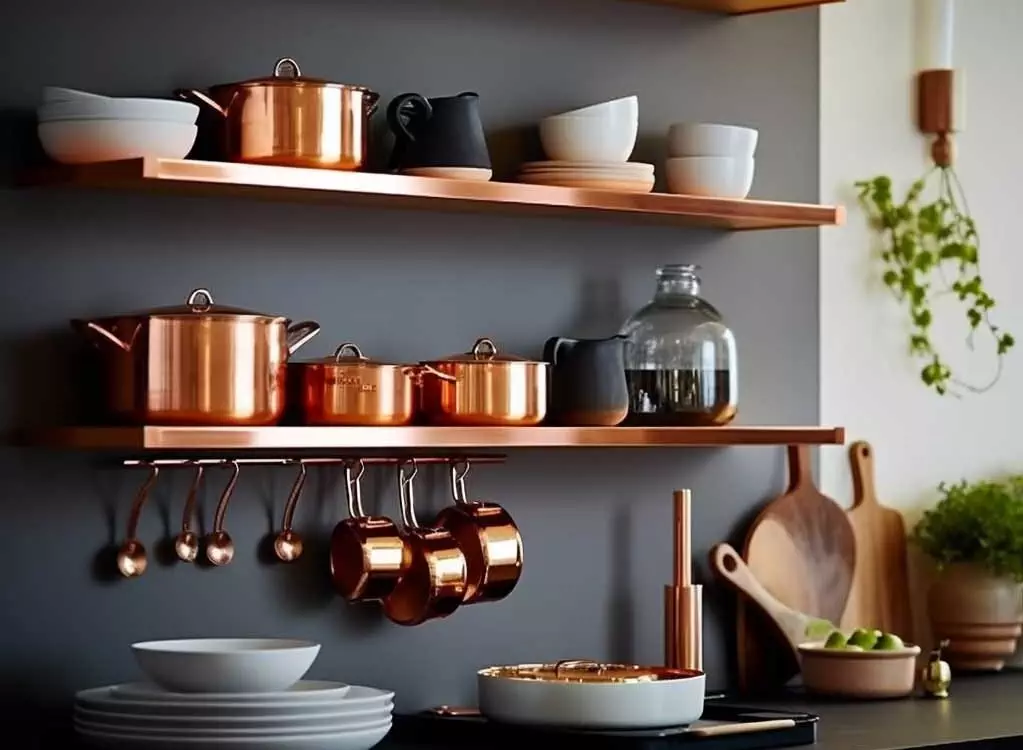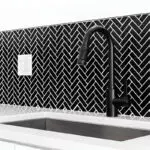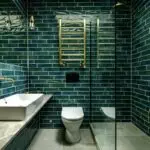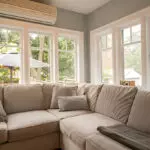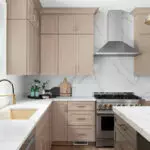Floating kitchen shelves have become increasingly popular in modern kitchen design, offering a sleek and minimalist storage solution that maximizes space and style. These shelves, on the wall give the kitchen an light ambiance offering storage for everyday essentials such as plates, glasses and recipe books. At Fineline Kitchens Inc we excel in crafting floating shelves, for kitchens that blend seamlessly with your kitchens design and style.
Table of Contents
ToggleHow to Decorate Floating Shelves in Kitchen
One of the best aspects of floating kitchen shelves is the opportunity to showcase your personal style and décor. Enhance the look of your floating kitchen shelves by blending ornamental pieces. Mix in dishes, cookbooks and decorative accents, like plants or artwork.
To add appeal vary the heights of items for an captivating arrangement. Infuse pops of color and intriguing textures to bring depth and personality to your floating shelves. Maintain order by grouping items for a neat and polished appearance. Follow these suggestions to achieve a blend of style and functionality, on your floating kitchen shelves.

How to Build Floating Shelves for Kitchen
Building your own floating kitchen shelves is a rewarding DIY project that allows you to customize the size, style, and placement of your shelves. Start by selecting high quality wood that matches the style of your kitchen and is capable of holding the weight of your items. Determine the dimensions and position of your shelves by measuring the wall space and deciding on the size and placement of your floating shelves.
Cut the wood to fit and smooth out the surfaces for a look. Use a concealed mounting system with a mounting bracket or a French cleat system to securely affix your floating shelves to the wall. Lastly complete the shelves by staining or painting them in your color and applying a sealant. With these steps, you can create custom floating kitchen shelves that perfectly fit your space.

What to Put on Floating Shelves in Kitchen
Floating kitchen shelves are versatile and can hold a variety of items to keep your kitchen organized and stylish. Show off your loved recipe books mixing bowls and handy kitchen gadgets such, as a coffee maker or blender. Utilize floating shelves to exhibit and store your assortment of cups, glasses and distinctive serving dishes.
Set up an herb garden by positioning herbs on your floating kitchen shelves for a refreshing organic vibe. Use containers or canisters to keep tidy and arrange essentials, like cooking utensils, spices or kitchen towels. Remember to infuse some character with pictures, artwork or sentimental trinkets. The options are limitless when it comes to deciding what to place on your floating kitchen shelves.

How Deep Should Floating Shelves be in Kitchen?
When installing floating kitchen shelves, it’s important to consider the depth to ensure they are functional and visually appealing. Floating shelves commonly come in sizes ranging from 6 to 12 inches, in depth. The best depth choice depends on what you intend to store and showcase. Smaller items such as spices, glasses or mugs are well suited for shelves with a depth of 6 to 8 inches.
If you aim to exhibit items, like plates, bowls or cookbooks consider opting for shelves with a depth of 10 to 12 inches. It’s important to note that deeper shelves may necessitate a mounting system and could occupy space visually in your kitchen. At Fineline Kitchens Inc we’re available to assist you in determining the depth for your floating kitchen shelves based on your storage requirements and kitchen design.

How High Should Floating Shelves be in Kitchen?
The height of your floating kitchen shelves is another important factor to consider for both functionality and aesthetics. The typical height, for the shelf should be around 18 to 22 inches above the countertop providing room for small appliances or items you use frequently. For shelves positioned above the one try to maintain a spacing of 10 to 15 inches between each shelf.
This setup allows for access and sufficient space, for displaying objects. If installing floating shelves above a sink or stove ensure there is at 24 inches of clearance to prevent splashes and heat related damage. Consider your own height and reach when determining the height of your floating kitchen shelves to ensure they are comfortable and accessible for daily use.

How Thick Should Floating Shelves be in Kitchen?
The thickness of your floating kitchen shelves plays a role in both the visual appearance and weight capacity of your shelves. Floating shelves typically come in sizes ranging from 1 to 2 inches thick. Thicker shelves give off a vibe while thinner ones offer a sleek modern appearance. The thicker shelves are great, for holding items such as iron cookware or large serving dishes whereas the thinner ones work well for lighter objects like glassware or small plants.
It’s important to note that thicker shelves might require a mounting system and can occupy visual space in your kitchen. At Fineline Kitchens Inc we provide customized floating kitchen shelves, in options to match your personal style and storage requirements.

How to Install Floating Kitchen Shelves
Installing floating kitchen shelves is a straightforward process that can be done in a few simple steps. First start by deciding where you want your shelves and marking the wall for the mounting hardware. Use a stud finder to locate the wall studs and mark their positions.
Then drill pilot holes, into the studs. Follow the manufacturers instructions to install the mounting hardware. If your shelves don’t already have holes drill matching ones in them for the hardware. Attach the shelves securely to the mounting hardware ensuring they are level. Cover any screws with wood filler. Touch up with paint or stain if necessary.

Are Floating Shelves Cheaper than Cabinets in a Kitchen?
In cases floating shelves are an alternative, to traditional kitchen cabinets. Unlike cabinets that involve materials and labor for construction and installation floating shelves offer a cost effective solution. They provide a way to enhance storage and display areas in your kitchen without the price tag associated with full cabinetry.
It’s worth noting that the cost of floating shelves may fluctuate based on factors, like material choices size variations and any customized features you opt for. At Fineline Kitchens Inc, we offer competitive pricing on our custom floating kitchen shelves and can work with you to find a solution that fits your budget and storage needs.

How to Hang Floating Shelves in Kitchen?
To set up floating kitchen shelves begin by deciding where you want them and marking the wall for the mounting hardware. Use a stud finder to locate the studs in the wall and mark their positions. If your shelves include a template, for mounting use it to mark where the screws will go. Drill pilot holes into the studs. Follow the manufacturers instructions to install the mounting hardware.
If your shelves don’t have pre holes drill holes in them to match the mounting hardware. Attach the shelves to the mounting hardware ensuring they are level and firmly in place. Cover any screws, with wood filler. Touch up with paint or stain if necessary. With these steps and the proper hardware, hanging your floating kitchen shelves is a simple and straightforward process.

Is Floating Shelves in Kitchen Against Built Ins?
Floating kitchen shelves offer an modern twist compared to built in cabinets. While built ins give a timeless and fixed storage solution floating shelves provide an personalized choice. They are easy to set up and reorganize based on your storage requirements allowing you to display your decorations and unique style in a way that built ins might not offer.
Nonetheless floating shelves may not offer concealed storage space as built ins do so it’s crucial to consider your specific storage needs when deciding between the two options. At Fineline Kitchens Inc we’re here to assist you in evaluating the advantages and disadvantages of floating shelves, versus built ins and finding the solution, for your kitchen.

What Type of Wood for Kitchen Floating Shelves?
When choosing the type of wood for your floating kitchen shelves, there are several factors to consider, such as durability, appearance, and cost. Oak, maple and walnut are commonly chosen for their strength and attractive grain patterns. They can support items well. Are less likely to bend or droop over time. Pine and cedar, on the hand are budget friendly options that can be stained or painted to fit your preferences though they may not be as durable as hardwoods.
Reclaimed wood provides a appearance, with its natural flaws and charm. When picking the wood for your floating shelves consider the overall aesthetic of your kitchen and the items you intend to display. At Fineline Kitchens Inc we have a range of wood choices. Finishes available to craft bespoke floating kitchen shelves that complement your space perfectly.

Where to Put Floating Shelves in Kitchen?
When deciding on the placement of floating shelves in your kitchen take into account the design and practicality of your space. Floating shelves are great, for storing used items above the sink stove or countertop helping to declutter your counters. They can also be utilized to fill up wall areas and showcase pieces.
Think about installing floating shelves in the corner of your kitchen to make the most of storage in an area that is often overlooked. Another idea is to create a coffee or tea station by positioning floating shelves, near your coffee machine or kettle. Ensure that you place the shelves where they’re easily reachable and won’t disrupt your kitchen tasks. At Fineline Kitchens Inc, we can help you determine the best placement for your floating kitchen shelves based on your unique space and needs.

What are the Rules for Floating Shelves in the Kitchen?
When you’re setting up floating shelves in your kitchen remember a guidelines, for practicality and safety. Firstly ensure that your shelves are securely fixed to the wall studs or use anchors for an steady hold. Secondly be mindful of the weight limit of your shelves. Refrain from overloading them with items.
Thirdly maintain sufficient spacing between shelves to easily reach and exhibit your belongings without overcrowding. Lastly position your shelves away from heat sources such, as the stove. Oven to prevent damage and potential fire risks. Finally, regularly dust and clean your floating kitchen shelves to maintain a hygienic and organized space. By following these guidelines, you can ensure your floating shelves are both stylish and functional in your kitchen.

Are Floating Shelves a Good Idea?
Floating shelves are a great idea for kitchens looking for a modern, minimalist storage solution. They offer several benefits over traditional cabinetry, including a sleek and open appearance, customizable sizing and placement, and a cost-effective option for added storage. Floating kitchen shelves can showcase your favorite dishware, cookbooks, and decorative items while keeping your countertops clutter-free.
They also allow for easy access to frequently used items and can be rearranged as your needs change. However, floating shelves may not provide as much closed storage as cabinets, so it’s important to consider your specific storage needs. Overall, floating kitchen shelves are a stylish and functional addition to any kitchen, and at Fineline Kitchens Inc, we can help you design and install the perfect shelves for your space.

Final Thought
At Fineline Kitchens Inc, we specialize in designing and installing custom floating kitchen shelves that perfectly fit your space and style. Our skilled team can assist you in understanding the guidelines and factors involved in setting up floating shelves in your kitchen. This includes selecting materials and locations well as ensuring a safe and sturdy installation.
We provide a variety of wood choices, finishes and sizes to craft shelves that harmonize with your kitchens style while offering storage and display solutions. Contact Fineline Kitchens Inc today to schedule a consultation and learn more about how we can transform your kitchen with stylish and functional floating shelves.

